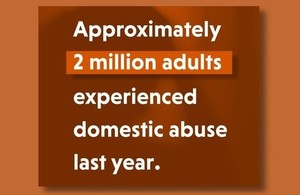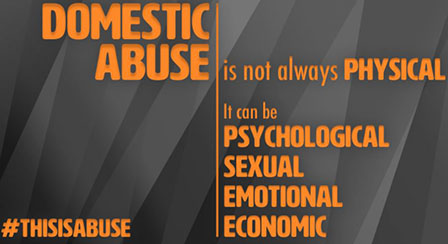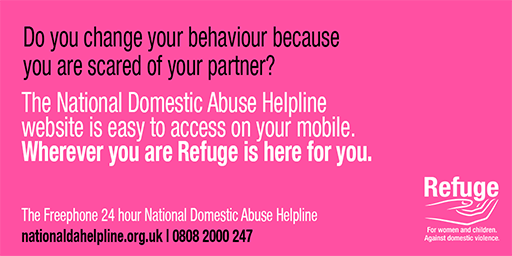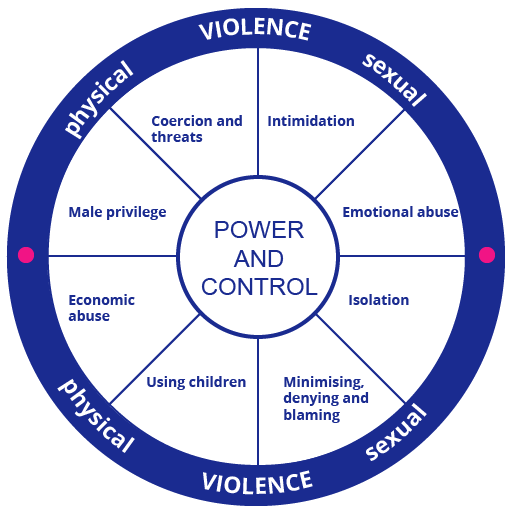Use 'Print preview' to check the number of pages and printer settings.
Print functionality varies between browsers.
Printable page generated Thursday, 20 November 2025, 6:39 PM
Introducing domestic abuse
1.1 Introduction
Digital badge and Statement of Participation

This suite of training modules has been produced by Support Through Court and the Open Justice Centre (Open University Law School). It contains a series of modules to support volunteers in their work with members of the public who are involved in court proceedings.
These first three key domestic abuse training modules provide advice and support on working with clients affected by domestic abuse, both survivors and alleged perpetrators.
There is a digital badge awarded for studying these key modules and you will also receive a Statement of Participation. To gain both of these you need to complete all three domestic abuse training modules and pass the Modules 1–3 knowledge assessment.
Welcome to this first training module on supporting clients where domestic abuse is a feature of their case. There are three domestic abuse modules and they are designed to be studied in order, from the first through to the third. These modules are:
1. Introducing domestic abuse
2. Supporting survivors of domestic abuse
3. Supporting clients who are accused of perpetrating domestic abuse.
Approximately 1 in 10 cases you deal with will feature domestic abuse. You will come across people who have experienced domestic abuse, perpetrators of abuse and those who have been accused of causing abuse. For some people, their experiences may make it more difficult for them to be involved with the court system, particularly where their case involves the alleged perpetrator of abuse. These training modules will assist you in feeling more confident in supporting clients in these situations.
Support Through Court do not want or expect volunteers to ‘diagnose’ domestic abuse or to become overly involved with clients. A three-step process for supporting clients, where domestic abuse is a feature of the case, is described in the module Supporting survivors of domestic abuse.
Please note
This module deals with some sensitive issues including descriptions of domestic abuse. These training modules are not compulsory, but they are recommended. If you do not feel comfortable to start the module, or if you are affected by the material, or feel you are unable to undergo the training, then Support Through Court can help you. Please speak to your Service Manager when you are next in the office.
If you need immediate support over the phone you can call:
National Domestic Violence Helpline – 0808 200 247
Learning outcomes
This first training module will help you understand domestic abuse and, in particular, controlling behaviour.
In this module you will learn about:
- What domestic abuse is
- Myths about domestic abuse
- What coercive control is
- Why survivors stay in abusive relationships.
This module is one of a number of training modules to help Support Through Court volunteers when supporting clients. The modules all use the same case study to explore the different aspects of supporting clients effectively. You will find details of the fictitious Johnson/Smith family and their situation in the next section of this module.
During the module you may come across terminology which is unfamiliar to you. Some words are hyperlinked to the Glossary, so by hovering over the word you will be able to see its definition.
Statistics around domestic abuse show that women are more likely to be survivors of abuse than men. For this reason, during the module we will be using ‘she’ to denote the survivor of domestic abuse and ‘he’ to denote the perpetrator, as this is the scenario you are more likely to come across in your volunteering.
However, domestic abuse can involve men as survivors and women as perpetrators, as well as abuse within same sex relationships. Support Through Court supports all clients regardless of their circumstances and so, you may come across different forms of relationships in your volunteering. This training will assist you to support clients whatever their gender or sexual orientation and regardless if they are alleged to have abused or are making allegations.
Domestic abuse used to be called Domestic Violence and some people still refer to it like that. However, because physical violence is only one form of domestic abuse, these days the broader term Domestic Abuse is preferred.
Whilst thinking about terminology we use the term ‘survivor’ in preference to ‘victim’ as survivor implies an active, creative, resourceful response (Women’s Aid, 2020). However, both terms can be used interchangeably, depending on the context.
Give your opinion
How would you rate your understanding of domestic abuse right now, before you start this module? Submit your answer.
1.2 Introduction to the Johnson/Smith family case study
Throughout our modules we will be using as an example a fictional family who have been involved in a domestically abusive relationship and their subsequent involvement in court proceedings.
Click on each image below to reveal the details of the family members:
In our case study, Jazmin has been in a relationship with Steve. She has alleged there was a history of domestic abuse and that she was controlled by her partner to the extent that it affected her mental health. Eventually, following an incident of physical violence she escaped the relationship and moved into emergency accommodation with her two children.
She says:
“At first Steve and I got on really well. He was always very generous and complimentary. After I became pregnant, his behaviour towards me changed. He started to get really jealous of me and my friends. He would behave badly if they came around and eventually, they stopped coming over. I was so tired looking after our baby and making sure Steve got what he wanted that I didn’t have time to myself anymore.
One day, I was late back from a doctor’s appointment. He went mad at me, saying I was having an affair. He smashed the place up and punched me in the face. I was holding our daughter at the time and Jaden was in the house, hiding in his bedroom. A neighbour called the police and they came and took him away. I was scared that when he got home he would do something worse, so whilst he was out of the house I managed to get away and get a room in a women’s refuge.
I have heard that he is trying to find where I am staying and wants to take the children from me. I am really scared.”
Steve was arrested following the final incident and is currently on police bail whilst investigations continue. He denies being violent or controlling and says that the injury to Jazmin was caused by a dispute Jazmin had with her drug dealer. He alleges that Jazmin takes drugs and was often incapable of looking after the children due to her drug misuse. He has not had contact with Chloe since the couple separated and he wants Chloe to stay over at his house when he is not working.
We will be referring to this example as we work though this module, so it may be helpful to remind yourself of the facts now. You may want to open this case study in a separate window (use Ctrl + click on the link to open in a new window) so you can refer back to it when needed.
1.3 What is domestic abuse?
The above statistic was published by the UK government when it published its draft
However, the first question we have to answer is ‘what is domestic abuse’?
Activity 1
Thinking about your experiences and volunteering, how would you describe domestic abuse?
Comment
There are two elements to domestic abuse.
The first is that it involves domestic, or familial, relationships. We typically think about relationships between current or former partners or spouses, but the government definition is much wider than this. It involves relationships between those aged 16 or over who are or have been intimate partners or family members, regardless of their gender or sexuality. This could involve partners and spouses but also mother, father, son, daughter, brother, sister and grandparents whether directly related, in-laws or step-family. It also includes same sex relationships.
The second element is that it involves abusive behaviours. These can include psychological, physical, sexual, financial or emotional abuse. Usually the abuse is not a one off event or confined to one type of abuse. Continuing abuse in a variety of different forms can have a particularly damaging effect on survivors and their wider family, such as children.
At Support Through Court we use the Home Office definition of domestic abuse, which is widely accepted:
“Any incident or pattern of incidents of controlling, coercive or threatening behaviour, violence or abuse between those aged 16 or over who are or have been intimate partners or family members regardless of gender or sexuality. This can encompass, but is not limited to, the following types of abuse: psychological; physical; sexual; financial; emotional.”
Not all unhappy relationships are abusive. Some couples argue and even fight with each other. What makes a relationship abusive is the intent and effect of the behaviour – the intent of the perpetrator and the effect on the survivor. A common theme in abusive behaviours is the feeling of fear experienced by the survivor.
For example, if a partner suddenly decides to stop doing chores around the house, in a healthy relationship there would almost certainly be a discussion and maybe even an argument between the partners. In an abusive relationship the survivor may acquiesce to the change in behaviour without challenge.
The key difference is fear.
In a healthy relationship there is no fear.
Activity 2
Part 1
Please answer the following multiple-choice questions. There is one correct answer for each question.
a.
A domestic or familial relationship
b.
Convictions for violence
c.
Injuries to the survivor
d.
Threats and coercion
The correct answer is a.
Answer
The correct answer is a domestic, or familial, relationship. The other three circumstances or types of behaviour may be present, but not in every case of domestic abuse.
a.
Violence within a same sex relationship
b.
Controlling behaviour between former partners
c.
Violence between neighbours
d.
Controlling behaviour between a parent and child
The correct answer is c.
Answer
The correct answer is violence between neighbours. This is because they do not have a domestic relationship (intimate partners or family members).
a.
Physical abuse only
b.
Physical and sexual abuse only
c.
Physical, psychological and sexual abuse only
d.
Physical, psychological, sexual, financial and emotional abuse
The correct answer is d.
Answer
The correct answer is physical, psychological, sexual, financial and emotional abuse. Financial and emotional abuse are increasingly recognised as important forms of abusive behaviour, often seen alongside other forms of abuse.
a.
Severity of the violence
b.
Fear
c.
How frequently the abuse occurs
d.
How long the relationship is
The correct answer is b.
Answer
The correct answer is fear. The frequency of violence and severity of violence can be evidence of a pattern of abuse but in isolation they may not always be indicative of an abusive relationship.
1.4 Myths about domestic abuse
Society is becoming more aware of the harm that domestic abuse causes to survivors, their children and to society as a whole (the Home Office estimated the cost of domestic abuse in 2017 as £66 billion (Home Office (2019)).
Attitudes to survivors of domestic abuse are changing as awareness increases. However, there are some myths which prevail. It is important to be aware of how our own values and things we have heard from others can affect our ability to empathise with and support clients effectively.
We will look at some of the more common myths you may experience in your volunteering below.
Activity 3
Do you agree with the explanations given about the statements? If not, what is your opinion?
Comment
Sometimes our own experiences and values can colour our perception of events and people. This is called
1.5 What is coercive control?
This section focuses on a specific type of abusive behaviour, coercive control. Coercive control is widely recognised as a particularly damaging type of abusive behaviour. However, because it is more subtle it can sometimes be more difficult for clients to evidence. Some may not even be aware that they have experienced this type of abuse. Remember we are not there to diagnose abuse, but an awareness of coercive control may enable you to empower clients to identify where they may be able to evidence abuse to the court.
Coercive control covers two specific types of behaviour, coercive control and controlling behaviour.
Activity 4
Part 3
Please answer the following true / false questions.
a.
True
b.
False
The correct answer is b.
Answer
The correct answer is False. Coercive control is one type of abusive behaviour. We have focused on it specifically as it can be more difficult to identify, as it involves a pattern of behaviour.
a.
True
b.
False
The correct answer is b.
Answer
The correct answer is False. Often coercive behaviour will involve both threats and intimidation and controlling behaviour. However, it may sometimes only involve coercive behaviour or controlling behaviour. Both types of abusive behaviour are domestic abuse.
a.
True
b.
False
The correct answer is b.
Answer
The correct answer is False. Many survivors say that the coercive control element of the abuse is much worse to endure, and more difficult to recover from, than the physical violence. It is well-evidenced that the negative impact of psychological abuse and coercive control can be as devastating as the trauma of experiencing physical attacks (Women’s Aid Federation, Northern Ireland)
Coercive and controlling behaviour is due to a power imbalance in the relationship, where the perpetrator is acting to ensure he has all the power and control in the relationship. If you were to speak to an abusive partner, they would probably not describe the aim of their behaviours as seeking power and control over their partner. They are more likely to talk about aspects of their partner or their behaviour that they dislike or would like to change. Nevertheless, the root lies in a quest for power and control.
Have a look at this diagram which illustrates the types of behaviour that perpetrators use to gain power and control over their partner. This diagram is called the
Activity 5
Thinking about your volunteering, how might you use Duluth’s power and control wheel in your volunteering?
Comment
When supporting clients who domestic abuse survivors, particularly survivors of coercive and controlling behaviour, it can help you identify and evidence the different ways an abusive partner can use power and control to manipulate a relationship. We will look at how to evidence abusive behaviour later on in the next module.
Hover over each segment of the wheel below to display the full definitions.
These tactics work together. If one doesn’t work the perpetrator may use a different one, or more than one. It is systematic and is done by choice with the intention of controlling the survivor and preventing their freedom of choice and action.
1.6 Identifying domestic abuse in Jazmin’s case
We are now going to look at our case study, the Johnson/Smith family. Remind yourself of the family and their situation.
In the first training module, you suspected Jazmin was a domestic abuse survivor. You decide to use Duluth’s power and control wheel to identify the coercive and controlling behaviour she was subject to.
Activity 6
From the description Jazmin gave you (which you have already read at the start of the module and is reproduced below), please highlight the acts which relate to each heading in the power and control wheel.
How to use the highlighter
Click on the colour you want to use and then drag your cursor over the text you want to highlight. The return arrow icon erases the single last highlighting you did. If you want to clear all of your highlighting use the Reset button. When you have completed all of your highlighting click on the Save button. To check your answers click on Reveal answer.
1.7 The process of being trapped in an abusive relationship
When domestic abuse is discussed, people will sometimes question why a person becomes involved in an abusive relationship. Research into the experiences of domestic abuse survivors shows that there is a process whereby control is exercised over the survivor and dependency encouraged, until the survivor is unable to leave the relationship or may not recognise its abusive nature.
Sometimes the process is so gradual that the survivor does not realise they are being controlled until another person points it out, such as a police officer (if the police have been called to an incident) or a support worker. If they realise what has happened whilst talking to a legal representative or someone involved in the court process, it may appear to an outsider that they have ‘suddenly made it up’, perhaps to get
When supporting a survivor of coercive and controlling behaviour, particularly where the behaviour has become more controlling over time, it is important to look at the whole picture and to appreciate that sometimes survivors may not realise everything what has happened to them.
Remember it is not our role to ‘diagnose’ domestic abuse. Understanding the process of control can help you identify when someone may need some additional support away from the court. You can signpost them to appropriate support organisations. It will also help you to support clients to be able to explain to the court what has happened to them.
Find Out More
According to research there are similarities between the tactics used by abusive partners and those used by the Chinese military to elicit “false confessions” from the “brainwashed” American prisoners of war held during the Korean War in the 1950s. Read more about domestic abuse theories and some other models of domestic abuse.
Radio and TV presenter, Lauren Laverne, a survivor of domestic abuse, describes the process of becoming trapped into an abusive relationship. She says:
“What I remember most about emotional abuse is that it’s like being put in a box. How you end up in there is the biggest trick. Maybe you think it’s a treasure box at first: you’re in there because you’re special.
“Soon the box starts to shrink. Every time you touch the edges there is an “argument”. So, you try to make yourself fit. You curl up, become smaller, quieter, remove the ‘offensive’ parts of your personality. You eliminate people and interests, change your behaviour. But still the box gets smaller. You think it’s your fault.”
Activity 7
Lauren is describing the process of being trapped in an abusive relationship. At first, the perpetrator makes the survivor feel special and wanted, so she starts to change her behaviour to please him. Making herself fit and the resulting isolation from other people and environments then causes her to rely on the perpetrator for everything. She doesn’t believe she can do anything for herself.
Through the emotional abuse she is made to believe she needs him. And eventually, she is trapped in this box, a box no one else can see. She doesn’t realise that the box is shrinking, or who is making it smaller at first. She doesn’t yet understand that she will never, ever be tiny enough to fit, or silent enough to avoid a row - no matter what she does or changes.
Activity 8
Thinking about your volunteering, have you supported a client who has described this process of becoming trapped in an abusive relationship? Why did they not recognise the abusive nature of the relationship?
Comment
Your response will vary depending on your volunteering experiences and the types of client you have worked with. However, many workers experienced in supporting clients who domestic abuse survivors will recognise this process of incremental control until the survivor is unable to recognise the abusive behaviour or leave the relationship, due to the control and dependency the perpetrator has established.
1.8 Why survivors stay in an abusive relationship
During your volunteering you will hear from survivors who have found it very difficult to leave an abusive relationship and you might find it difficult to understand this. There will be other cases where a survivor leaves the relationship but then re-starts the relationship. This might be when the perpetrator is brought back into the survivor’s life, possibly as a result of court proceedings such as an application for a child arrangements order.
In order to support clients during these proceedings, it is important to understand why a survivor might struggle to leave the relationship or be tempted to start the relationship again.
Activity 9
Activity 10
Think about the factors a survivor has to consider when she decides whether to leave an abusive relationship. Please complete the following table as best as you can.
Looking at all of the losses and gains, what do you think a domestic abuse survivor might feel being in the middle space above? If she has been isolated, totally reliant on her partner then she potentially loses a lot by leaving. This might include a home, belongings, finances, any support systems she has in place and her peace of mind regarding her future and children. She may feel lost, desperate, totally alone, frightened, anxious for the future and unhappy.
With all of these emotions. if she believes there is a chance that the relationship might change or be different in the future (for example, because the perpetrator has told her this), she might remain in the relationship, or go back to it, until she has exhausted all hope of making the relationship work. This could explain why domestic abuse survivors find it so difficult to leave a relationship and go back to the relationship once they have left.
Give your opinion
How would you rate your understanding of domestic abuse after completing this module? Submit your answer .
1.9 Your volunteering and domestic abuse
Activity 11
Thinking about what you have learnt domestic abuse, please complete the following questions.
1.10 Conclusion
This module has helped you to recognise where clients have experienced domestic abuse and explain how to best support them in your first contact with them.
In this module you have learned about:
- What domestic abuse is
- Myths about domestic abuse
- What coercive control is
- Why survivors stay in abusive relationships.
There are three domestic abuse modules, which are designed to be studied in order. As you have completed the first, you can now look at the second module ‘Supporting survivors of domestic abuse’.
The next two modules are:
- Supporting survivors of domestic abuse
- Supporting clients who are accused of perpetrating domestic abuse
Support Through Court have a suite of training modules which you can complete so please do take a look at the other modules available. You can study these in any order. They include:
- Special measures
- Working with Cafcass
- Interviewing clients
- Writing statements
- Signposting clients to other organisations
- Working with vulnerable people
Give your opinion
Well done, you have completed this module.
How much will completing this module help you in your volunteering when dealing with clients who have experienced domestic abuse? Submit your answer.
References
Acknowledgements
Grateful acknowledgement is made to the following sources:
Every effort has been made to contact copyright holders. If any have been inadvertently overlooked the publishers will be pleased to make the necessary arrangements at the first opportunity.
Important: *** against any of the acknowledgements below means that the wording has been dictated by the rights holder/publisher, and cannot be changed.
267971: Course banner image: © monkeybusinessimages / iStock Editorial / Getty Images Plus
266485: 1.1 Support through court logo: Support through court
1.2 The Johnson/Smith family:
266470: Jazmin (top left): tommaso79 / iStock / Getty Images Plus 266472: Steve (top right): tommaso79 / iStock / Getty Images Plus 266477: Jaden (bottom left): Ridofranz / iStock / Getty Images Plus 266476: Chloe (bottom right): JBryson / iStock / Getty Images Plus
266558: 1.3 What is domestic abuse statistic: Home Office and Ministry of Justice (2019) News story: Government publishes landmark domestic abuse bill, available online at https://www.gov.uk/government/news/government-publishes-landmark-domestic-abuse-bill Reproduced under the terms of the OGL, www.nationalarchives.gov.uk/doc/open-government-licence
266567: 1.3 What is domestic abuse definition: Home Office and Ministry of Justice (2018) Transforming the response to domestic abuse: graphics and animations, Promotional material, https://www.gov.uk/government/publications/transforming-the-response-to-domestic-abuse-graphics-and-animations Reproduced under the terms of the OGL, www.nationalarchives.gov.uk/doc/open-government-licence
266569: 1.3 Domestic Abuse Helpline: Refuge, https://www.refuge.org.uk/
266675: 1.5 Coercive Control definition: UK SAYS NO MORE, uksaysnomore.org
269055: 1.5 Duluth power and control wheel: 'Duluth wheel of power and control’, Domestic Abuse Intervention Program (DAIP), https://www.theduluthmodel.org/wheels/
271083: 1.5 Duluth power and control wheel interactive: 'Duluth wheel of power and control’, Domestic Abuse Intervention Program (DAIP), https://www.theduluthmodel.org/wheels/
266710: 1.7 Lauren Laverne: Ben A. Pruchnie / Stringer / Getty Images
266470: 1.8 Jazmin Activity 10: tommaso79 / iStock / Getty Images Plus
266470: 1.8 Jazmin Activity 10 answer : tommaso79 / iStock / Getty Images Plus






